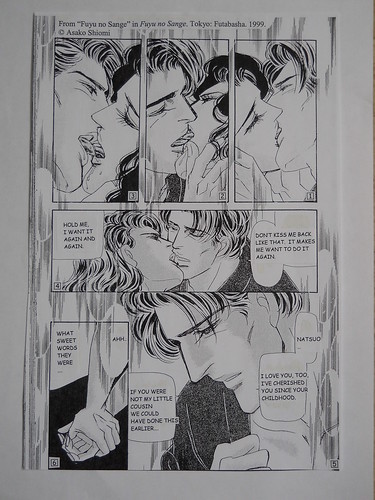Curator's Note
In my book, A Sociology of Japanese Ladies' Comics: Images of the Life, Loves, and Sexual Fantasies of Adult Japanese Women (2011), more than 10,000 pages of Japanese ladies' comics were analyzed. The book studies the images of women, their social status, gender roles, family relations, love lives, and sexuality. It asks the question "What kinds of realities are depicted in regard to Japanese women’s everyday life?"
Ladies' comics emerged in the 1980’s during the time of Japanese economic expansion, when women gained more social and financial independence and enjoyed more sexual freedom. The comics appeared as an extension of girls’ comics with more love, romance, and sex. They captivated the hearts of many Japanese women. However, unlike boys' and girls' comics, ladies' comics have not been translated.
This page on my poster is from a comic book titled Fuyu no Sange drawn by Asako Shiomi (translated by me). Shiomi started her career as a girls' comic artist in the 1970s, and her manga have encompassed several categories from touching human dramas in girls’ comics to the sexual fantasies of S & M in ladies' comics.
Shiomi said that her comics always have narrative with plots, story lines, intricate web of human emotions, feelings, and interactions between a woman and a man, and thus they are different from pornography. She portrays carnal pleasure of a heroine at the very moment when she realizes that she is a sexual subject. Sexuality constitutes one’s sense of self, and accepting it as it is leads to an emergence of a new self and elimination of sexual repression.
As avid fans of girls' comics grow up to be young adults, Japanese ladies' comics will be translated and published in many countries in the near future. Just like Ukiyoe and sexually explicit Shunga ("spring pictures"), Japanese ladies' comics will influence global popular culture.
Today there is an ordinance that censors contents of adult manga. Shiomi regrets this kind of movement because she lives in a democracy where the freedom of speech and expression is guaranteed. Should a country like Japan censor manga?

Comments
Censorship and Access in Ladies' Comics
Thank you for such a fascinating addition to the theme week, Kinko. As you pointed out ladies' comics are an area of Japanese popular culture that is not as widely experienced in the West as other texts due to the lack of translated materials. However, these materials play an important role in the manga industry and the recent move towards censorship has created a problem for both fans of this particular genre and its producers.
Censorship and sexuality have an interesting relationship in Japanese media (particularly with their pornography). You have raised a very interesting question concerning censorship and freedom of speech, and in instances such as this (where the materials are not pornogography yet are still highly sexualized) that question is paramount.
In response to the question you posed, I have several new questions that build directly upon it. From what I gather, this law was passed a few months ago. Has this had a big impact on the ladies' comics that have been published since? I was also wondering if these new laws intended to completely stop these sorts of narratives or are they intended to try and restrict access to certain materials for underage users? I think the question of democracy and freedom of speech intersects directly with the question of access, as media effects fears are prevalent whenever there are sexually explicit or violent texts.
Lastly, do you think the question of "access" is one of the reasons these manga have not been translated and exported to Western cultures? While some Western comic book stores contain "erotic" sections, these ladies' comics do not really fit completely into that realm.
Add new comment